This is a list of the breeds of horse native to the Iberian peninsula, and considered in Portugal and Spain to have originated wholly or partly in those countries. Inclusion here does not necessarily imply that a breed is predominantly or exclusively of Iberian origin.
The Altér Real, Garrano, Lusitano, Ponei da Terceira and Sorraia are of Portuguese origin;[1] the Garrano is equivalent to the Pura Raza Gallega of Spain.
A Spanish Royal Decree of 2008 listed fourteen native breeds (Asturcón, Burguete, Caballo de Monte del País Vasco, Pura Raza Gallega, Pura Raza Española ("Andalusian"), Hispano-Árabe, Hispano-Bretón, Jaca Navarra, Losino, Mallorquín, Marismeño, Menorquín, Monchino and Pottoka), of which all but the Andalusian were at risk of extinction; the Spanish Trotter and Caballo de Deporte Español were listed separately.[2] The Pirinenc Catalá was added in 2012,[3] and the Caballo del las Retuertas in 2016.[4] The Serrano received regional recognition from the Community of Madrid in 2011.[5]: 100 [6]
The horses of the peninsula are commonly classified in various groups or clades, confirmed by microsatellite studies. These may include: the northern or Atlantic Celtic ponies or small horses, which show similarities to British breeds such as the Exmoor Pony; the southern or Mediterranean breeds of Celtic origin, including the Mallorquín and Menorquín; the hot-blooded breeds, including the imported Arab and Thoroughbred, as well as the Spanish Trotter; and the Iberian horses, including the Pura Raza Española, the Lusitano, the Alter Réal and the Marismeño, which are closely related to the horses of North Africa. The Retuertas does not fall within any of these groups.[7][8][9]
| Local name(s) | English name if used | Image | Notes |
|---|---|---|---|
| Asturcón[10]: 21 | 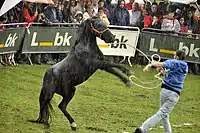 | 2001 population: 873;[11]: 57 semi-feral | |
| Altér Real[12]: 434 | .jpg.webp) | Portugal | |
| Burguete[10]: 21 | 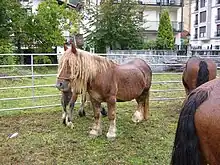 | 2001 population: 3300;[11]: 57 heavy work and meat horse | |
| Caballo de Deporte Español[13] | Spanish Sport Horse |  | 2001 population: 2350[11]: 56 |
| Caballo de las Retuertas[10]: 21 | Retuertas | population 60-140; feral, first described in 2005[14] | |
| Caballo de Monte del País Vasco[10]: 21 | Basque Mountain Horse | 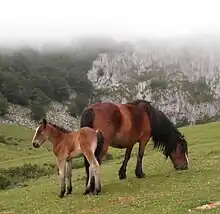 | 2001 population: 2300;[11]: 57 semi-feral meat horse |
| Galician Pony | .jpg.webp) | 2001 population: 650;[11]: 57 semi-feral; 20,000–22,000 unregistered horses, known as faco or del país;[15] Spanish equivalent of the Garrano[7] | |
| Catalán | extinct since the first third of the twentieth century[10]: 445 | ||
| Garrano[1] | 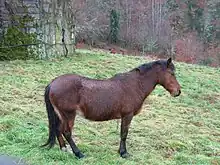 | population >950;[13] semi-feral; Portuguese equivalent of the Caballo de Pura Raza Gallega[7] | |
| Hispano-Árabe[10]: 21 | 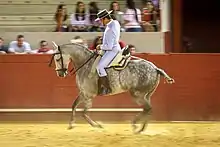 | 2001 population: 2464[11]: 55 | |
| Hispano-Bretón[10]: 21 | .jpg.webp) | 2001 population: 4561;[11]: 57 work and meat | |
| Jaca Navarra[10]: 21 | 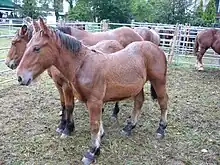 | 2001 population: 390;[11]: 57 semi-feral | |
| Losino[10]: 21 |  | 2001 population: 169;[11]: 57 semi-feral | |
| Lusitano[1] | 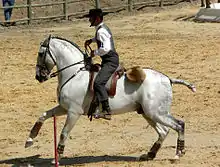 | Portugal; population 23,619 | |
| Mallorquín[10]: 21 | 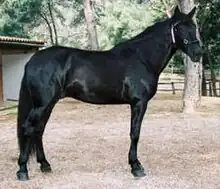 | 2001 population: 172[11]: 57 | |
| Marismeño[10]: 21 | .jpg.webp) | population 1051, semi-feral | |
| Menorquín[10]: 21 | .jpg.webp) | 2001 population: 1647[11]: 57 | |
| Mérens | 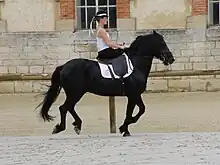 | population >7000[13] | |
| Monchino[10]: 21 | .jpg.webp) | 2001 population: 1004[11]: 57 | |
| Pirinenc Catalá[3] | .jpg.webp) | population 7133; recognised in 2012 | |
| Ponei da Terceira[1] | Terceira Island, Azores, Portugal | ||
| Pottoka[10]: 21 | Pottok | .JPG.webp) | 2001 population: 532;[11]: 57 some semi-feral |
| Andalusian horse |  | 2001 population: 75,389[11]: 49 |
| Serrano | not nationally recognised, regional recognition only (Community of Madrid)[5]: 100 [6] | ||
| Sorraia[1] |  | Portugal, population >100, semi-feral | |
| Trotador Español | Spanish Trotter | 2001 population: 6823, of which 85% in the Balearic Islands[11]: 53 [16] | |
References
- 1 2 3 4 5 Breed data sheet: Portugal: Horse. Domestic Animal Diversity Information System of the Food and Agriculture Organization of the United Nations. Accessed July 2019.
- ↑ Elena Espinosa Mangana (26 December 2008). Real Decreto 2129/2008, de 26 de diciembre, por el que se establece el Programa nacional de conservación, mejora y fomento de las razas ganaderas (in Spanish). Ministerio de Medio Ambiente, y Medio Rural y Marino. Boletín Oficial del Estado. 23 (27 January 2009): 9211–9242. Reference BOE-A-2009-1312. Accessed July 2021.
- 1 2 Miguel Arias Cañete (9 February 2012). Orden AAA/251/2012, de 9 de febrero, por la que se modifican el Anexo I del Real Decreto 2129/2008, de 26 de diciembre, por el que se establece el Programa nacional de conservación, mejora y fomento de las razas ganaderas, el Anexo del Real Decreto 558/2001, de 25 de mayo, por el que se regula el reconocimiento oficial de las organizaciones o asociaciones de criadores de perros de raza pura y el Anexo III del Real Decreto 841/2011, de 17 de junio, por el que se establecen las condiciones básicas de recogida, almacenamiento, distribución y comercialización de material genético de las especies bovina, ovina, caprina y porcina y de los équidos (in Spanish). Ministerio de Medio Ambiente, y Medio Rural y Marino. Boletín Oficial del Estado. 39 (15 February 2012): 13452–13455. Reference BOE-A-2012-2254. Accessed July 2021.
- ↑ Isabel García Tejerina (29 July 2016). Orden AAA/1357/2016, de 29 de julio, por la que se modifica el anexo I del Real Decreto 2129/2008, de 26 de diciembre, por el que se establece el Programa nacional de conservación, mejora y fomento de las razas ganaderas; el anexo del Real Decreto 558/2001, de 25 de mayo, por el que se regula el reconocimiento oficial de las organizaciones o asociaciones de criadores de perros de raza pura; y el anexo III del Real Decreto 841/2011, de 17 de junio, por el que se establecen las condiciones básicas de recogida, almacenamiento, distribución y comercialización de material genético de las especies bovina, ovina, caprina y porcina y de los équidos (in Spanish). Ministerio de Agricultura y Pesca, Alimentación y Medio Ambiente. Boletín Oficial del Estado. 191 (9 August 2016): 56904–56907. Reference BOE-A-2016-7639. Accessed July 2021.
- 1 2 Élise Rousseau, Yann Le Bris, Teresa Lavender Fagan (2017). Horses of the World. Princeton: Princeton University Press. ISBN 9780691167206.
- 1 2 [staff] (14 March 2011). El caballo serrano será recuperado (in Spanish). Madrid: Madridiario. Accessed July 2021.
- 1 2 3 L.J. Royo, I. Álvarez, A. Beja-Pereira, A. Molina, I. Fernández, J. Jordana, E. Gómez, J.P. Gutiérrez, F. Goyache (2005). The origins of Iberian horses assessed via mitochondrial DNA. Journal of Heredity. 96 (6): 663–669.
- ↑ Thomas Jansen, Peter Forster, Marsha A. Levine, Hardy Oelke, Matthew Hurles, Colin Renfrew, Jürgen Weber, Klaus Olek (2002). Mitochondrial DNA and the origins of the domestic horse. Proceedings of the National Academy of Sciences. 99 (16): 10905–10910. doi:10.1073/pnas.152330099.
- ↑ J.L. Vega-Pla, J. Calderón, P.P. Rodríguez-Gallardo, A.M. Martinez, C. Rico (2006). Saving Feral Horse Populations: Does It Really Matter? A Case Study of Wild Horses from Doñana National Park in Southern Spain. Animal Genetics. 37 (6): 571–78. doi:10.1111/j.1365-2052.2006.01533.x. (subscription required).
- 1 2 3 4 5 6 7 8 9 10 11 12 13 14 15 16 Miguel Fernández Rodríguez, Mariano Gómez Fernández, Juan Vicente Delgado Bermejo, Silvia Adán Belmonte, Miguel Jiménez Cabras (eds.) (2009). Guía de campo de las razas autóctonas españolas (in Spanish). Madrid: Ministerio de Medio Ambiente y Medio Rural y Marino. ISBN 9788449109461.
- 1 2 3 4 5 6 7 8 9 10 11 12 13 14 15 [s.n.] (December 2003). Estudio y caracterizacion del sectór equino en España (in Spanish). Madrid: Tragsega; Ministerio de Agricultura, Pesca y Alimentación.
- ↑ Valerie Porter, Lawrence Alderson, Stephen J.G. Hall, D. Phillip Sponenberg (2016). Mason's World Encyclopedia of Livestock Breeds and Breeding (sixth edition). Wallingford: CABI. ISBN 9781780647944.
- 1 2 3 Breed data sheet: Spain: Horse. Domestic Animal Diversity Information System of the Food and Agriculture Organization of the United Nations. Accessed July 2019.
- ↑ J.L. Vega-Pla, J. Calderón, P.P. Rodríguez-Gallardo, B. Alcaide, F.T.P.S. Sereno, M.R. Costa, E. Pérez-Pineda, J.V. Delgado, C. Rico (2005). The Retuertas horse: the "missing link" in the Iberoamerican horse breeds origin?. In: Imre Bodó, Lawrence Alderson, Bertrand Langlois (2005). Conservation genetics of endangered horse breeds. European Association for Animal Production publication 116. The Netherlands: Wageningen Academic Publishers. ISBN 9789076998794, pages 167–176.
- ↑ Cristina Barral (15 November 2010). Unos 22.000 caballos salvajes pastan en libertad en los montes gallegos (in Spanish). La Voz de Galicia. Accessed July 2019.
- ↑ Pedro Javier Azor, Mercedes Valera, María Dolores Gómez, Félix Goyache, Antonio Molina (2007). Genetic characterization of the Spanish Trotter horse breed using microsatellite markers. Genetics and Molecular Biology. 30 (1): 37–42. doi:10.1590/S1415-47572007000100009